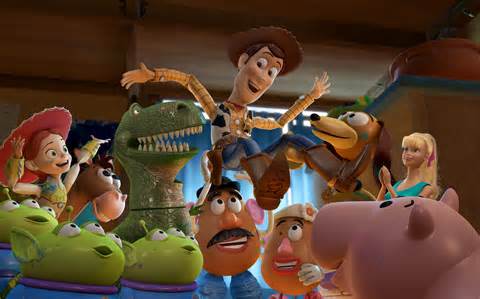The Disney Pixar movie, Toy Story, is loved by young and old alike. This is the reason the beloved characters and story were continued through two subsequent movies, Toy Story 2 and Toy Story 3, making it a trilogy of behavior to evaluate (and enjoy!). The characters in the movie span personality characteristics across many dimensions allowing the audience to relate to all the characters. The group of toys owned by Andy is a small, well-constructed work group in which Woody the cowboy is the leader. Woody’s leadership can be assessed through the “Leadership Grid”, developed by Blake and Mouton (1985) (Northouse, 2012) in reference to the skills approach. Woody employs a Team Management style when employing his leadership behaviors as compared to the Leadership Grid. Blake and Mouton (1985) state that most leaders have a dominant management style that they use most of the time; however they utilize a backup style in times under pressure (Northouse, 2012). Woody’s backup style lies with the Authority-compliance management spectrum.
The Skills Approach attempts to view leadership actions and behaviors. Two categories have arisen through both the Ohio State Studies in the late 1940s, based on studies by Stogdill (1948) and the University of Michigan Studies around the same time (Northouse, 2012). The most common developmental tool through this approach, the Leadership Grid, was created by Blake and Mouton in 1964 and has been revised several times (Northouse, 2012). The two categories according to the Leadership Grid by Blake and Mouton (1985) are concern for production and concern for people. These categories reflect initiating structure and consideration, coined by Stogdill (1974), and employee orientation and production orientation labeled by the University of Michigan studies (Northouse, 2012). Concern for production is attributed to issues such as attention to policy decisions, workload, and process issues (Northouse, 2012). In essence the concern for production behavior category is what the leadership behavior is seeking to accomplish. Concern for people contains such behavior as promoting positive social relations, good working conditions, and building organizational commitment and trust (Northouse, 2012).
Retrieved from: http://clouducation.wordpress.com/2012/03/07/5-educational-leadership-realities/
Woody is in the leadership position of the group of toys. His behavior is illustrated throughout all 3 of the movies. His style is reflective in Team Management on the Leadership Grid. Team Management leader behavior is seen as: “stimulates participation, acts determined, gets issues into the open, makes priorities clear, follows through, behaves open-mindedly, and enjoys working”(Northouse, 2012, p. 81). His leadership behaviors are committed to doing what will keep the toys safe and being available for their owner Andy when he needs them. Woody engages the toys in weekly meetings to keep all the toys committed and informed, to educate on safety and protocol, or as needed when a problem arises. During meetings the toys are encouraged to participate and share ideas with the group. In the original movie, when Andy is having a birthday party, the toys are congregated together to receive the information of which new toys Andy receives so that the toys are prepared for whatever comes their way. Woody continually supports the other toys by reaffirming their place in Andy’s room. No matter what Andy receives they will deal with it together and no one is being thrown away, a large fear among toys. The process by which they find out what Andy receives for his birthday is well constructed and orchestrated by Woody, showing his concern for production. The army guys are deployed orderly to obtain the information and Woody has the toys in Andy’s room gathered to hear the news. Woody knows what is needed to accomplish the goals that are set.
In Toy Story 3, Woody is concerned for the well-being of not only the toys but Andy as well. Although Andy has grown, Woody is committed to being available if he should ever need him or the other toys. Woody continually acts determined to this end and gets issues out into the open. Both the meetings and ultimate goal commitment are demonstrative of Team Management from the Leadership Grid (Northouse, 2012). Woody stimulates the group to share their ideas and thoughts so that they may stay together. The group’s thoughts are important to Woody as the leader and although he does not always agree with the group, he is continually open-minded in receiving their thoughts and ideas. The toys have also discussed what they have learned at such meetings as “Rust Prevention” and “Battery Safety” throughout the trilogy, illustrating Woody’s continual policy development and education to the group. His persistence to keep the group safe and committed through his openness to ideas, his stimulation of participation from the group, his determination, and making the priorities clear show his Team Management style of leadership.
Through the skills approach Leadership Grid, Blake and Mouton (1985) said that most leaders have a dominant style and at times, use a backup style (Northouse, 2012). There are times where Woody feels that the group is jeopardizing their safety and in these moments, while under pressure, employs his backup style. Woody tends to shift his style to the Authority-Compliance Management style as a backup. In this type of leadership style the leader is seen as controlling and demanding (Northouse, 2012). These situations tend to arise in the movies in several capacities. In Toy Story 3, Woody feels as though they should stay with Andy but the group does not want to be stored away and never played with so they feel they should move on. Woody attempts to assert his authority by demanding the group stay with Andy. When under pressure, Blake and Mouton (1985) state that the leader will resort to their backup style (Northouse, 2012). Woody only resorts to this type of behavior when he feels the group is making the wrong decision and feels pressured to do so as though he has no other option to change their minds.
Woody and the gang from Toy Story exhibit the leader and subordinate relationship that resembles Team Management Style from the Leadership Grid developed by Blake and Mouton (1985) (Northouse, 2012). As discussed, Woody only deploys his backup style when under pressure. The safety and commitment of the toys to Andy is fostered in a positive environment by Woody in order to preserve the group’s emotional needs and well-being. Woody displays more commitment to the overall goals and group than most leaders we see today.
References
Northouse, Peter G. (2013). Leadership: Theory and Practice. Sixth Edition. Sage Publications.













